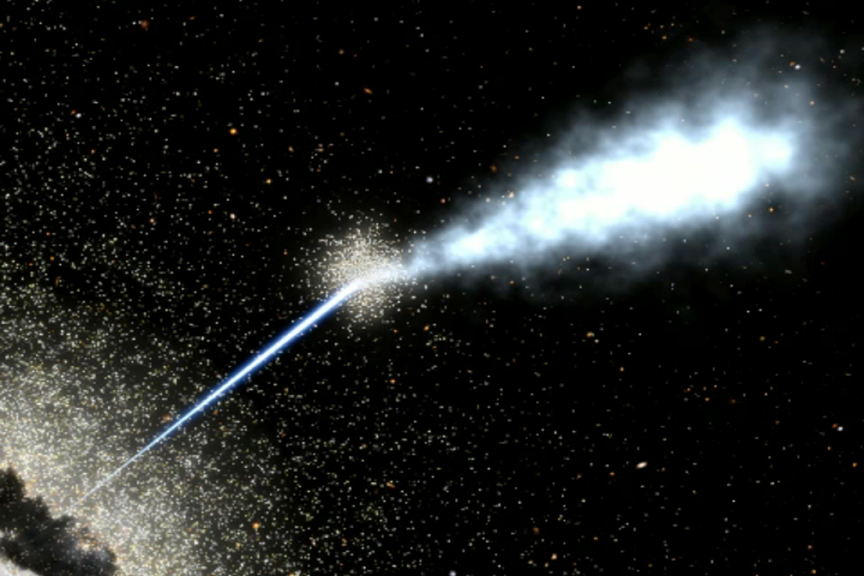The "Death Star Galaxy": An Insider's Scoop
Hello! Hopefully by now you'll have read a little about 3C 321, aka the "Death Star Galaxy" from
I first became interested in solving the conundrum of 3C 321’s twisted jet back in 2005, and was fortunate enough to observe the galaxy in December of that year while on a visit to the Jodrell Bank Observatory in Cheshire, UK. The instrument I used, MERLIN, provided us with a fantastic high-resolution radio image of the jet, which revealed its warping and twisting to be even more dramatic than anyone had previously realized. But what was causing the jet to seemingly take on a life of its own? Well, one of the great things about astrophysics at the moment is that for the first time we have the ability to make high-quality observations of astrophysical objects right across the electromagnetic spectrum. Radio galaxies such as 3C 321 are a great case in point. Observations at radio wavelengths tell us about the morphology and energy of the jet, with optical and infrared data we can learn about the gas and stars in the galaxies that host jets, while Chandra X-ray observations tell us about how black holes material in their vicinity, amongst many other things. When we first superimposed our radio, optical, and Chandra X-ray images of 3C 321 we were pretty sure we’d cracked the origin of the warped jet – that it had struck the side of a neighboring galaxy as it raced outwards. This was an interesting result, not least because we could use the physics of such a unique collision to better understand how jets propagate and dissipate their energy. A few days later, I showed the image to my science imager friend Eli Bressert, who makes some of the wonderful Chandra pictures you see on our website. Eli went to work and produced the stunning multiwavelength image that’s become synonymous with 3C 321. At that point, not only did we know that we had an interesting science result, but a story to tell… * What happened next? A press conference. Ouch. Most astrophysicists, me included, don’t have much experience in dealing with the media, so the NASA and Chandra press offices thankfully staged a series of planning teleconferences to guide us through the process. They also arranged for Neil deGrasse Tyson, director of the Hayden Planetarium in New York, to take part as a panelist in our conference. Neil is the media’s “go-to†guy when they need commentary on physics topics, so having him taking part in our conference was a real plus. In the days running up to the press conference, the press offices worked hard to produce some amazing animations of the jet slamming into the neighboring galaxy, which not only looked great but would hopefully help to sell the story to the press. * 15 Minutes of Fame! Within minutes after the conference ended, my phone began ringing, and barely stopped for the next few days. I fielded a huge number questions from reporters, and was whisked around to studios for various radio and television interviews. I even had a few calls from worried members of the public, seeking reassurance that they weren’t about to be caught up in cosmic obliteration…! Still, our story ended up making the front pages of several national newspapers, which definitely make good mementoes of my 15 minutes of fame! Finally, I’d like to say that the whole media experience, far from being a distraction from our day-to-day research, actually forces scientists to temporarily take a step back from sitting at our desks performing calculations and think much more about the big-picture astrophysics we can learn from observatories such as Chandra. I’d like to express my thanks to the co-authors on our paper, to be published next month in the Astrophysical Journal, and of course the Chandra and NASA press offices for their unswerving patience and amazing skills in turning a science journal article into an interesting result for the public! -Dan Evans
Armed with the draft of the scientific paper and a great image, I went to see my colleagues in the Chandra Press Office, and spoke to them about the physics of the jet collision in 3C 321. I guess that one of the things the Press Office looks for in a story is a human angle, so the idea of an earthlike planet being pummeled by a deadly jet of particles and radiation was quickly discussed. I must confess, however, that the consequences of X-rays and gamma-rays from a jet irradiating a planetary atmosphere weren’t exactly the main goals of our paper…! Still, my colleague Martin Hardcastle and I dug out some research papers on this topic, and calculated that the effects of the 3C 321 jet on a planet would be pretty disastrous. The Chandra Press Office then pitched a potential press release to NASA Headquarters, who agreed that the release should be a “big†one and take the form of a phone-in press conference.
A still from the animation
December 17th: The Big Day. The press conference went surprisingly well; all the panelists managed to convey our points to the media, who showed a real interest in return. Neil Tyson was an absolute star throughout, and rounded off the conference in typical fashion: “This is a reminder that you are not alone in the universe. You are not isolated. You are not an island. So avoid black holes when you can."
Please note this is a moderated blog. No pornography, spam, profanity or discriminatory remarks are allowed. No personal attacks are allowed. Users should stay on topic to keep it relevant for the readers.
Read the privacy statement
